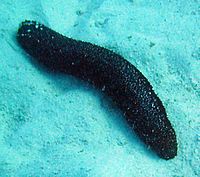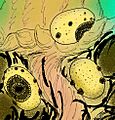Deuterostome facts for kids
Quick facts for kids DeuterostomiaTemporal range: late Ediacaran – Recent
|
|
|---|---|
 |
|
| A sea cucumber | |
| Scientific classification | |
| Kingdom: | |
| (unranked): | |
| Superphylum: |
Deuterostomia
Grobben, 1908
|
| Phyla and clades | |
|
|
Deuterostomes are a large group of animals. They are part of a bigger group called bilaterian animals. This means their bodies can be divided into two similar halves.
Deuterostomes are different from another group called protostomes. The main difference is how their embryos develop. In deuterostomes, the first opening that forms in the embryo becomes the anus. In protostomes, this first opening becomes the mouth.
Contents
What are Deuterostomes?
Deuterostomes are a "superphylum." This is a way to group animals that are very similar. It helps scientists understand how different animals are related. This group includes many animals you know, like humans!
Main Deuterostome Groups
There are several important groups, or phyla, of deuterostomes. These groups include both living and extinct animals.
Living Deuterostome Phyla
- Chordata: This group includes all vertebrates. Vertebrates are animals with a backbone. Humans, fish, birds, and reptiles are all chordates.
- Echinodermata: These are sea animals. They include starfishes, sea urchins, and sea cucumbers. Many echinoderms have spiny skin.
- Hemichordata: This group includes animals like acorn worms. They are often found in the ocean. Some ancient animals called graptolites might also be in this group.
Extinct Deuterostome Groups
- Saccorhytida: This is a group of very old, extinct deuterostomes. Scientists have found fossils of these tiny animals. They help us understand how early deuterostomes looked.
Images for kids
See also
 In Spanish: Deuterostomia para niños
In Spanish: Deuterostomia para niños


